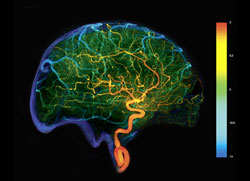Siemens sets a new standard in subtraction angiography

Previously, multiple black and white image frames had to be reviewed to visualize the contrast medium flow through the blood vessels. Now with the colors of syngo iFlow the representation of contrast from its initial entry into the blood vessels to its flow throughout can be shown in one image.
The syngo iFlow application, for example, can be used to enhance pre-procedural and postprocedural imaging of patients under treatment for leg stenosis. Flow deviations and the increased utilization of collaterals can more easily be detected prior to intervention, since anomalies more readily attract the physician's attention due to their specific colors. Following the intervention, the success of a balloon dilatation or stent implantation of a stenosis is readily visible due to the improved flow.
In order to obtain a color image, syngo iFlow takes the time to maximum opacification of each individual pixel, starting with the injection and subsequently visualizing the distribution of the contrast medium through the vessels. These time measurements are then represented by a color allowing visualization of the complete vessel tree in one image. With syngo iFlow, Siemens extends its range of advanced imaging applications for the Artis zee.
Artis zee is the family name of the Siemens systems used for interventional radiology and cardiology. These systems, available in biplane, multi-axis, ceiling-mounted, floor-mounted, and multi-purpose configurations allow Siemens to provide a complete portfolio of solutions to match customers needs.
Media Contact
More Information:
http://www.siemens.comAll latest news from the category: Medical Engineering
The development of medical equipment, products and technical procedures is characterized by high research and development costs in a variety of fields related to the study of human medicine.
innovations-report provides informative and stimulating reports and articles on topics ranging from imaging processes, cell and tissue techniques, optical techniques, implants, orthopedic aids, clinical and medical office equipment, dialysis systems and x-ray/radiation monitoring devices to endoscopy, ultrasound, surgical techniques, and dental materials.
Newest articles

Recovering phosphorus from sewage sludge ash
Chemical and heat treatment of sewage sludge can recover phosphorus in a process that could help address the problem of diminishing supplies of phosphorus ores. Valuable supplies of phosphorus could…

Efficient, sustainable and cost-effective hybrid energy storage system for modern power grids
EU project HyFlow: Over three years of research, the consortium of the EU project HyFlow has successfully developed a highly efficient, sustainable, and cost-effective hybrid energy storage system (HESS) that…

After 25 years, researchers uncover genetic cause of rare neurological disease
Some families call it a trial of faith. Others just call it a curse. The progressive neurological disease known as spinocerebellar ataxia 4 (SCA4) is a rare condition, but its…





















